

What are Additives Additives are substances put into food during processing in order to improve it in some way They may be natural eg spices or herbs or artificial eg tartrazine which is a yellow colour in sweets and soft drinks ID: 1038031
Download Presentation The PPT/PDF document "What I Will Learn To explain what an add..." is the property of its rightful owner. Permission is granted to download and print the materials on this web site for personal, non-commercial use only, and to display it on your personal computer provided you do not modify the materials and that you retain all copyright notices contained in the materials. By downloading content from our website, you accept the terms of this agreement.
1.
2. What I Will LearnTo explain what an additive is and why they are used in food processing
3. What are Additives?Additives are substances put into food during processing in order to improve it in some way. They may be natural, e.g. spices or herbs, or artificial, e.g. tartrazine, which is a yellow colour in sweets and soft drinks.Additives must be tested for safety before they are used in food. Once passed, they are given an ‘E’ number. The number means that the additive has been passed by EU law. The amounts used in food are strictly controlled.If a substance enters a food indirectly, e.g. from packaging, air or careless handling, it is known as a contaminant.
4. Additives on Food LabelsFood labels must state:The type of additive, e.g. colouring, flavouring or preservative The chemical name of the additive or its E numberThe use of food additives must not mislead the consumer with issues related to the nature, freshness and quality of ingredients used, and must be of benefit to the consumer.
5. What are Additives Used For?Additives are used to:Improve the taste and texture of the foodMake the food look appetising Preserve the foodEnsure that the food stays safe to eat for longer, reducing the risks of food poisoning Make food easier to prepare
6. AdditiveColourings E100—E199Types of AdditivesFunction Improve appearance of foodReplace colour lost in processingGive colour to food that would otherwise be colourlessSatisfy consumer expectationsUsed inDairy spreads, soups, saucesGravy and brown saucesSoft drinks, sweetsExampleChlorophyll (E140) greenCaramel (E150) brownTartrazine (E102) yellow
7. AdditivePreservatives E200–E299ExampleSaltSugarVinegarUsed inBaconJamPicklesFunction Prevent food spoilage Extend shelf lifePrevent food poisoningReduce wasteEnsure a greater variety of food is available out of seasonTypes of Additives (continued)
8. Types of Additives (continued)AdditiveFlavourings (not on E list)ExampleSalt, pepper, herbs, spicesUsed inStock cubes, cakesFunction To improve or intensify tasteSweeteners Sugar and honeyAspartame (E951), e.g NutraSweet, Canderel Saccharine (E954), e.g. HermesetesCakes and biscuitsLow-calorie drinks and diabetic foodTo sweeten foods Used instead of sugar
9. Did You Know? Monosodium glutamate (E621) is a flavour enhancer found in many snack foods. It stimulates the taste buds. Artificial sweeteners make many foods sweet without adding calories.
10. Types of Additives (continued)Emulsifiers or stabilisersE400–499Lecithin Mayonnaise Help oil and water to mix and stay mixed Prevents sauces separatingFunction Prevent foods containing fats from spoiling (going rancid)Used inDairy spreadsExampleVitamin EVitamin CAdditiveAntioxidantsE300–399Nutritive additivesIronVitamin BBreakfast cereals, milk, breadImprove the nutritional value of food
11. Are Additives Good or Bad?AdvantagesAdditives improve the colour, flavour and texture of food.They preserve food, which prevents waste and reduces the risk of food poisoning.Give us a wider choice of foods all year round.They help maintain the quality of preserved food.DisadvantagesSome people are allergic to certain additives. Some additives deceive the consumer, e.g. sugar may be listed as dextrose, glucose, sucrose, etc.Foods may contain more additives than necessary.Possible side effects, e.g. hyperactivity in children, cancer.
12. Class ActivitiesWhat is an additive? Why are they used in foods?Look at the four labels on next four slides. Can you identify the additives in each product?Identify what type of additive each one is.
13. Label 1
14. Label 2
15. Label 3
16. Label 4
17. Label 1Label 2Label 3Label 4FoodList four main ingredients Are there any ingredients you are unfamiliar with? What is the function of this ingredient? In pairs, choose four processed food labels from the box and examine them. Record the information on a table like the one below.Research Activities
18. Practical ActivitiesIn Pairs: Visit the ready meals aisle in your local supermarket and choose four ready meals to compare.Note the price and number of portions contained in the meals. Choose your favourite and bring it into class. Cook or reheat them in class and join up with another pair. Taste the two dishes and compare them under the headings on your evaluation sheet. See Activity 17.11 in the TRB